

Slow Living Essentials: A Hugelkultur Experiment. One of the things I am enjoying with the school year routine starting back up is the return of the veggie gardening group I am in.
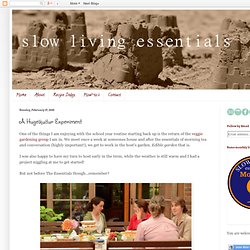
We meet once a week at someones house and after the essentials of morning tea and conversation (highly important!) , we get to work in the host's garden. Edible garden that is. I was also happy to have my turn to host early in the term, while the weather is still warm and I had a project niggling at me to get started! But not before The Essentials though...remember? Even the pooch had a play date! The work started with a shovelside 'conference' as it so usually does. A plan was formed and soon the hard work commenced. The Many Benefits of Hugelkultur. Hugelkultur, pronounced Hoo-gul-culture, means hill culture or hill mound.
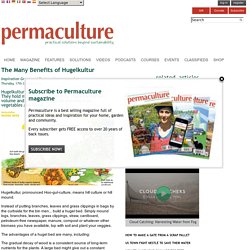
Instead of putting branches, leaves and grass clippings in bags by the curbside for the bin men... build a hugel bed. Simply mound logs, branches, leaves, grass clippings, straw, cardboard, petroleum-free newspaper, manure, compost or whatever other biomass you have available, top with soil and plant your veggies. The advantages of a hugel bed are many, including: The gradual decay of wood is a consistent source of long-term nutrients for the plants. A large bed might give out a constant supply of nutrients for 20 years (or even longer if you use only hardwoods).
Soil aeration increases as those branches and logs break down... meaning the bed will be no till, long term. An Edible Forest Garden in Tennessee: Hugelkultur. We have been very busy working in our garden the last few months.

First we built a tall fence enclosing an area of 70 ft x 60 ft with one 6 ft gate. We used field fence 4 ft high with 4" x 2" welded wire fencing going up 1 ft and then bending outward away from the fence for 1 ft, which will keep burrowing animals out. Finally, we put bamboo poles up about 6 ft off the ground all around the top to keep deer out. Next, we put in two Hugelkultur beds. The Many Benefits of Hugelkultur. Hugelkultur: the ultimate raised garden beds. Raised garden bed hugelkultur after one month raised garden bed hugelkultur after one year.
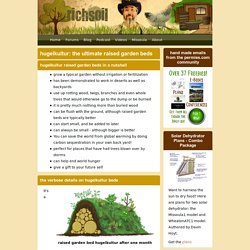
Soil. Soil is the mixture of minerals, organic matter, gases, liquids and a myriad of micro- and macro- organisms that can support plant life.
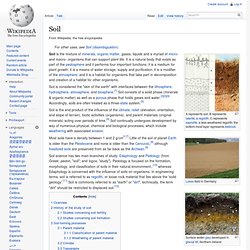
It is a natural body that exists as part of the pedosphere and it performs four important functions: it is a medium for plant growth; it is a means of water storage, supply and purification; it is a modifier of the atmosphere; and it is a habitat for organisms that take part in decomposition and creation of a habitat for other organisms.
Soil is considered the "skin of the earth" with interfaces between the lithosphere, hydrosphere, atmosphere, and biosphere.[1] Soil consists of a solid phase (minerals & organic matter) as well as a porous phase that holds gases and water.[2][3][4] Accordingly, soils are often treated as a three-state system.[5] Overview[edit] Soil is a major component of the Earth's ecosystem. Soils can effectively remove impurities, kill disease agents, and degrade contaminants. History of the study of soil[edit] In 1856 J. Curtis F. Soil. An important factor influencing the productivity of our planet's various ecosystems is the nature of their soils.

Soils are vital for the existence of many forms of life that have evolved on our planet. For example, soils provide vascular plants with a medium for growth and supply these organisms with most of their nutritional requirements. Discovering an Oasis in the American Desert. We’re out in the hot Sonoran Desert, somewhere near Tucson, Arizona.
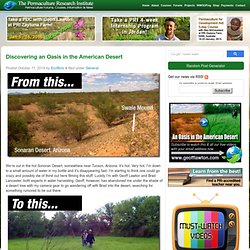
It’s hot. Very hot. I’m down to a small amount of water in my bottle and it’s disappearing fast. I’m starting to think one could go crazy and possibly die of thirst out here filming this stuff. Luckily I’m with Geoff Lawton and Brad Lancaster, both experts in water harvesting. A mythical Moby Dick for a permaculture enthusiast – a big mother swale. Bill Mollison visited these swales in the Global Gardner TV series twenty years ago. Until now, that is. Various Permaculture students had reported online to have photographed a few of these swales and said it was all over-hyped. Looking at the harsh surrounding desert environment, I was beginning to believe they were right. How to Permanently Improve Your Sandy Soil. Size of a pumpkin leaf: 42 cm, that’s 16.5″.
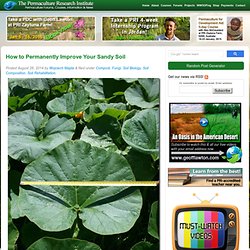
Vermont Compost Company » How our Compost is Made. A Commitment to our Compost The Compost: Vermont Compost Company’s primary goal is to provide the highest quality composts and potting soils to growers, enabling them to realize their plant growing goals.
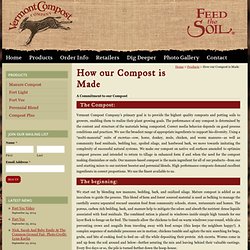
The performance of any compost is determined by the content and structure of the materials being composted. Correct media behavior depends on good process conditions and practices. We use the broadest range of appropriate ingredients to support bio-diversity. The beginning: We start out by blending raw manures, bedding, bark, and oxidized silage. Maturation: As the mixture of ingredients reaches the end of our feed houses, the mix begins to look homogeneous—food scraps are no longer identifiable, Temperatures have been above 131º for at least 15 days, and the pile has shrunk greatly in volume.
The Potting Soil: While our composts are excellent amendments to soils, they are not usually appropriate for use as complete media in seedling trays, pots, or beds.